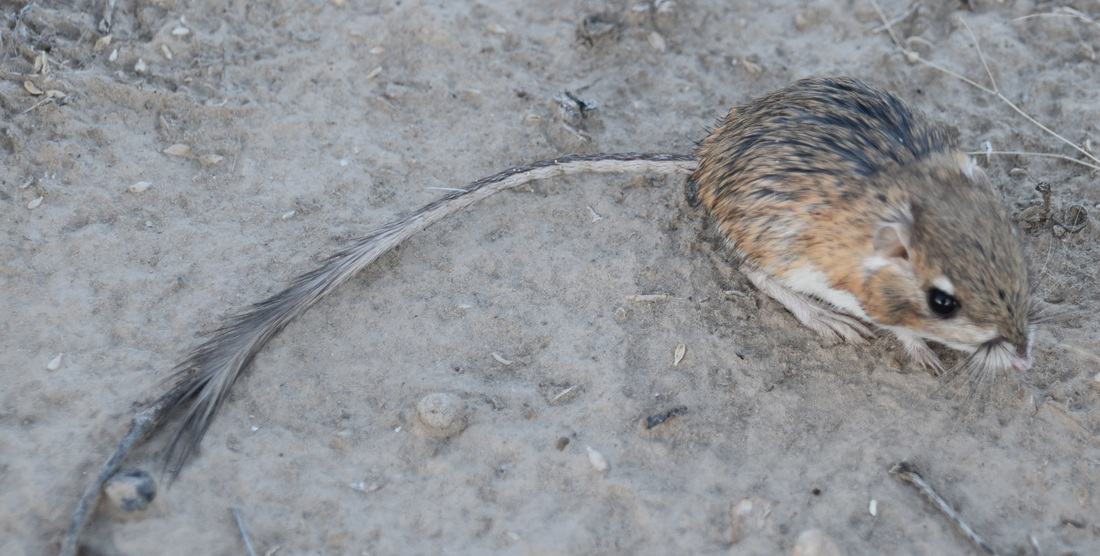Pages from the field... A Blog
|
The day after my last post, we drove up Alamo Road to Dead Horse Road, which follows a difficult wash from the basin west of the Sheep Mountains, up around Dead Horse Ridge and into the pinyon pine and juniper forests of the Sheep Mountains. It took us a long time to drive the "road", with a few stops for moving large rocks and checking to make sure that we were on the right road. At the end of the road, we set up our camp and set out about 100 small rodent traps to see what was lurking in the brush. The temperature was cool, and we could feel the weather changing, and even the birds seemed antsy - a couple flew right into our camp and seemed very unafraid of us. Lesser Goldfinches playing in our wash water... We had lots of birds around the camp - including Pinyon Jays (50+), Northern Flicker, White-crowned Sparrows, Chipping Sparrows, Vespers Sparrows, Cassin's Finches, and of course Red-tailed Hawks, and Common Ravens. On our second night, the sky darkened, the wind picked up, and some serious clouds rolled in. Because we were a long way up a seriously-difficult-to-drive wash, we had concerns about the road washing out. Although we were ready to do what we needed to do to get out, we were lucky that the storm didn't bring much overall rain, and spread it over more than 24 hours - giving the ground plenty of time to soak up the water.  And of course - the end of the rain was mixed with bouts of bright sun and beautiful rainbows. Nothing like a rainbow in the desert... When the rain lifted, we took a long walk up to Perkin's Spring, to check out the condition of the drinker and to look for chipmunks that might be unusual. The views (like the view above) was beautiful from the slopes of the Sheep Range (looking west here toward Alamo Road). Although we saw many cliff chipmunks, we didn't see or hear any chipmunks that resembled the threatened Hidden Forest Chipmunk. Back in camp, we saw a few tarantulas, probably the desert tarantula (Aphonopelma iodius) that is common in the area. The males are commonly seen making long treks in the evening light - often walking along roads or walks that remain warm from the afternoon sun. This is Merriam's kangaroo rat (Dipodomys merriami), the most common k-rat in the area. We caught these at every elevation where we trapped - from Dead Horse Road camp to White Sage Flat. Although I tried to get photos of several other small mammal species, they all moved too fast when I let them go to get good photos. Even this guy was a little out of focus. After several days of working and trapping along Dead Horse Road, we came back to the basin and White Sage Flat. The above photo was taken from White Sage Flat looking back at the car on Alamo Road and the Sheep Ranges in the background. Very few Joshua trees lived on the flat, although creosote and J-trees were common in the habitats all around the old dry lake bed to the west of Alamo Road. Here you can see our camp just north of White Sage Flat. We trapped up into the hills and around the camp on our last night (in addition to trapping some of the northern end of the old dry lakebed) but pretty much all we caught were Merriam's kangaroo rats, some Peromyscus deer mice, and some Onychomys grasshopper mice. In fact - the grasshopper mice were quite common here - named after their food, since they eat largely insects and other arthropods, unlike most mice that are granivorous. I have heard that Onychomys is resistant to scorpion venoms, because they have co-evolved with scorpions, and they can resist even the most toxic species of Centruroides scorpion that could be dangerous to humans.
Overall, the trip was great, and we got excellent data from a variety of small mammal species. The list of small mammal species that we documented on this trip included the following: Desert Cottontail (Sylvilagus audubonii) Black-tailed jackrabbit (Lepus californicus) White-tailed antelope ground squirrel (Ammospermophilus leucrurus) Long-tailed pocket mouse (Chaetodipus formosus) Merriam's kangaroo rat (Dipodomys merriami) Chisel-toothed kangaroo rat (Dipodomys microps) Desert woodrat (Neotoma lepida) Southern grasshopper mouse (Onychomys torridus) Western harvest mouse (Reithrodontomys megalotis) North American deermouse (Peromyscus maniculatus) Canyon deermouse (Peromyscus crinitus) Cactus deermouse (Peromyscus eremicus) Pinyon deermouse (Peromyscus truei) several bats that we could not ID Coyotes (Canis latrans) calling at night (but never seen) Desert bighorn sheep (Ovis canadensis) And here is a list of bird species that we documented: Turkey Vulture Northern Harrier Cooper's Hawk Red-tailed Hawk Sandhill Crane Great Horned Owl Common Poorwill White-throated Swift Belted Kingfisher Red-naped Sapsucker Ladder-backed Woodpecker American Kestrel Prairie Falcon Say's Phoebe Loggerhead Shrike Pinyon Jay Western Scrub-Jay Common Raven Mountain Chickadee Bushtit Red-breasted Nuthatch Rock Wren Cactus Wren Ruby-crowned Kinglet Sage Thrasher American Pipit Cedar Waxwing Chipping Sparrow Brewer's Sparrow Dark-eyed Junco White-crowned Sparrow Sagebrush Sparrow Vesper Sparrow Song Sparrow Spotted Towhee Red-winged Blackbird Western Meadowlark Great-tailed Grackle House Finch Purple Finch Cassin's Finch Pine Siskin Lesser Goldfinch Lawrence's Goldfinch
1 Comment
Joan Dumbacher
10/24/2015 01:49:27 pm
Great pictures and your work is interesting. Also very informative to find out all the technology that enters into these studies. You not only touched on the mammals and birds in the area but the weather and terrain. You are definitely not living it up under these circumstances.
Reply
Your comment will be posted after it is approved.
Leave a Reply. |
Pages from the field
Jack Dumbacher's Blog. I am an evolutionary biologist and ecologist studying birds and mammals. I live for field work, but the genetics lab can be fun too... And living in the Bay Area is always full of surprises. Archives
November 2017
Categories |








 RSS Feed
RSS Feed